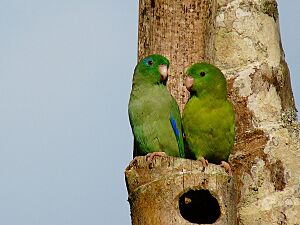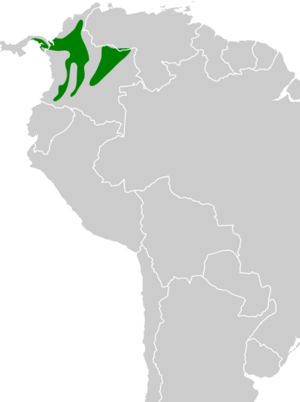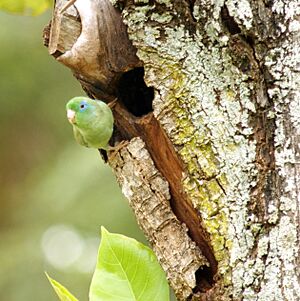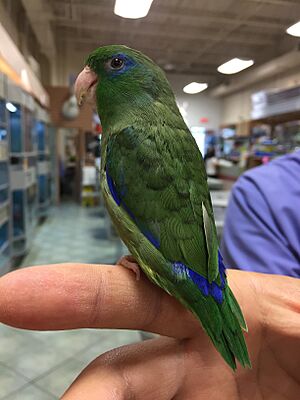Spectacled parrotlet facts for kids
Quick facts for kids Spectacled parrotlet |
|
|---|---|
 |
|
| A pair in Colombia (male left, female right) |
|
| Conservation status | |
| Scientific classification | |
| Genus: |
Forpus
|
| Species: |
conspicillatus
|
| Subspecies | |
|
|
 |
|
The spectacled parrotlet (Forpus conspicillatus) is a small, colorful parrot that belongs to the family Psittacidae. These birds are known for the bright rings around their eyes, which look a bit like spectacles.
There are three types, or subspecies, of spectacled parrotlets: the main one called F. c. conspicillatus, the Cauca spectacled parrotlet (F. c. caucae), and the Venezuelan spectacled parrotlet (F. c. metae).
Contents
What Do Spectacled Parrotlets Look Like?
Spectacled parrotlets are usually about 12 centimetres (4.7 in) long. They weigh around 30 grams (1.1 oz), which is about the same as a few quarters. Most of their body is green, with a gray-green chest and belly. Their heads are a brighter green. They have dark brown eyes and light peach-colored beaks and feet.
These parrotlets show something called sexual dimorphism. This means males and females look different. Male spectacled parrotlets have a bright blue ring around each eye. They also have purple-blue feathers on their lower back, rump, and parts of their wings. Females do not have these blue markings. Instead, they have a bright emerald green ring around each eye.
Like all parrots, spectacled parrotlets have zygodactyly. This is a fancy word meaning two of their toes point forward and two point backward. This helps them grip branches and climb easily. Young parrotlets look like the adults, but young males might have some green feathers mixed in with their blue markings.
Different Types of Spectacled Parrotlets
- Spectacled parrotlet (Forpus conspicillatus conspicillatus): This is the most common type. It lives in eastern Panama and northern Colombia.
- Cauca spectacled parrotlet (F. c. caucae): The blue markings on the males of this type are a bit lighter. Females have thicker beaks than the other types. You can find them in western Colombia.
- Venezuelan spectacled parrotlet (F. c. metae): The blue rings around the eyes of the males in this type go further back behind their eyes. They live in central Colombia and western Venezuela.
Where Do Spectacled Parrotlets Live?
Spectacled parrotlets are native to Middle and South America. This includes northern and central Colombia, Venezuela, and eastern Panama. Each subspecies lives in specific parts of these countries.
They like to live in places with lots of trees and open spaces. Their natural habitats include the edges of lowland evergreen forests, thorny bushes, grasslands, and areas with scattered trees. They can also live in places where forests have been cut down but still have some trees. You won't find spectacled parrotlets living higher than 1,600 metres (5,200 ft) above sea level.
Their green and blue feathers help them blend in with the tropical trees. This is called camouflage. It helps them hide from animals that might try to eat them. Sometimes, parrotlets born in captivity might have different colors, like yellow patches. But these color changes are very rare in the wild. Bright colors would make it harder for them to hide from predators.
How Are Spectacled Parrotlets Doing?
The IUCN Red List says that spectacled parrotlets are a Least Concern species. This means they are not currently in danger of disappearing. In fact, their numbers are stable and might even be growing. This is partly because they prefer open areas over dense forests. So, as some forests are cleared, it creates more suitable places for them to live. There are also many protected areas where they live, which helps keep them safe.
Behavior and Life in the Wild
What Do Spectacled Parrotlets Eat?
In the wild, spectacled parrotlets eat many different things. Their diet includes seeds, nuts, leaves, and various berries and fruits, like those from the Tamarindus plant. Sometimes, they might even eat small insects. They have also been seen licking or eating clay. This clay is important because it gives them minerals, such as calcium, which they need to stay healthy.
How Do Spectacled Parrotlets Socialize?
Spectacled parrotlets are very social birds. They usually live in small groups, but you can sometimes see very large flocks of up to 100 birds. These big groups often gather at clay mounds to drink water or eat the clay.
Reproduction and Life Cycle
Male parrotlets use their bright colors and special calls to attract females. Spectacled parrotlets usually have their babies between January and March.
They build their nests in holes in trees or similar spots. Often, they will use old nests made by other birds in tree holes or clay mounds. But they can also make their own new nests. The female bird sits on the eggs to keep them warm, which is called incubating. The male's job is to guard the nest and bring food to the female and the baby chicks once they hatch. Spectacled parrotlets are monogamous, meaning they stay with one partner. Some pairs even stay together for their whole lives.
After a female lays her first egg, she will lay another one every two days. A typical group of eggs, called a clutch, has 4 to 6 eggs. The eggs hatch after about 18 days of incubation.
Baby parrotlets leave the nest, or fledge, when they are about five weeks old. Brothers and sisters from the same clutch stay close to each other for a few weeks after they fledge. They use special calls to talk to each other, share food, and play. They do this until they are old enough to take care of themselves.
How Do Spectacled Parrotlets Communicate?
Spectacled parrotlets are good at telling the difference between their friends and other birds. They can even change their calls to sound like the bird they are talking to. They use different calls for different messages. These calls are sometimes described as sounding like "names."
Their calls can sound like tweeting, chirping, or buzzing, depending on what they are trying to say.
When kept as pets, spectacled parrotlets can learn to copy the sounds their owners make. Male parrotlets are often better at mimicking sounds than females. This is because in the wild, males naturally use calls to attract a mate.
Spectacled Parrotlets as Pets
In recent years, spectacled parrotlets have become more and more popular as pets. People keep them as breeding pairs or as single companions.
Breeding Pairs
If you want to breed spectacled parrotlets, they usually don't make good companion pets. This is because they should not be handled much if they are meant for breeding. Breeding pairs need a special closed nest box, which is like a tree hole nest in the wild, so they can lay eggs and raise chicks.
Hand-Fed Birds
Hand-fed parrotlets are much more popular as pets. Baby parrotlets are taken from their nests when they are a few weeks old. They are then fed a special, nutritious mash that looks like baby food. This mash is full of protein, fats, and minerals that the chicks need to grow. Young chicks are fed with a syringe three to four times a day. They eat about 2–4 cubic centimetres (2.0–4.0 mL) of mash at each feeding.
As the bird grows, it needs to be fed less often and with less food. By the time they are four to six weeks old, the parrotlet will start eating mixed grains or pellets on its own. Chicks that are handled often from a young age usually stay friendly and enjoy spending time with their owners outside the cage. However, if a bird is not taken out of its cage regularly after it stops needing hand-feeding (this is called weaning), it might become wild, nervous, or even aggressive.
What Do Pet Parrotlets Need?
Spectacled parrotlets need cages that are roughly 24 inches by 24 inches by 18 inches. They also need perches of different sizes and textures. This helps keep their nails filed down and gives their feet exercise. Toys, especially ones that make them work for treats (called foraging toys), encourage them to play actively and chew. Chewing helps keep their beaks healthy.
Many owners choose to clip their parrotlet's flight feathers. This is a safety measure to prevent the bird from flying away or getting hurt. Usually, the first six main flight feathers are trimmed. These feathers will grow back when the bird molts, which happens about twice a year. Their nails should also be clipped every four months to stop them from getting too long and to make sure they can perch comfortably.
A pet parrotlet's diet usually includes mixed grains or pellets. Mixed grain diets often have white millet, sunflower seeds, and other types of seeds. Pellets are often preferred because they are very nutritious. Pellet diets are usually made with extra proteins and minerals like calcium. This helps make sure the bird gets all the important nutrients it would naturally find in its food in the wild.




